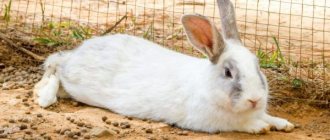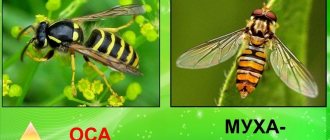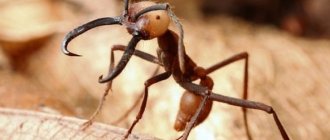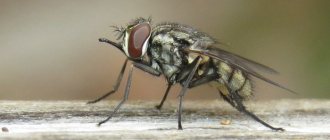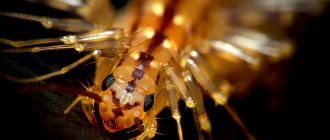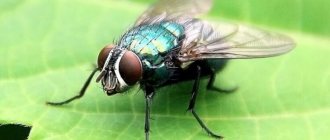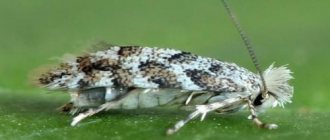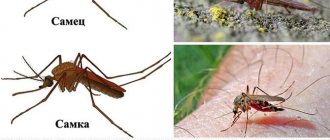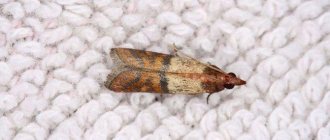As summer begins to wind down, in August and early fall, “the flies become aggressive and angry.” Is this statement true, and are all these insects really starting to behave so bloodthirsty for some reason?
In fact, it is difficult to imagine an insect capable of experiencing emotions characteristic of humans, including anger. But what then makes flies attack people in order to feed on blood at the end of summer - beginning of autumn, and how true is the myth about their increasing aggression during this cool time?
Do all flies bite?
Ordinary house flies, so annoying with their constant buzzing and omnipresence since spring and throughout the summer, it turns out, are not at all to blame for the fact that, unknowingly for most people, they have been “caught” in increased aggression. Their absolute “alibi” is their physical inability to bite anyone. The proboscis of ordinary flies is too soft to pierce the skin of a person or animal, and is created by nature only to suck out juice, feed on liquid and soft food such as fibers of fruits or vegetables, rotting organic matter, etc.
The true “aggressors” are the autumn fly flies, which really bite in August and early autumn. It is because of them, outwardly so similar to their indoor counterparts, that the incorrect generalization began, claiming that by autumn all flies begin to “get angry” and attack.
Preventive measures
To prevent the appearance of pests, it is important to carry out preventive measures. Excellent conditions for the reproduction and residence of pests - heat, humidity, presence of organic waste
Therefore, the following rules must be observed:
- Keep the house, sheds and yard clean. Remove dirt in a timely manner, throw out garbage (preferably once every 1-2 days), do not leave dirty dishes with food residues, regularly ventilate the room.
- Take care of pets and birds. Remove droppings from them, clean their habitats, and wash the animal if necessary.
- Keep the area clean - cover trash containers, mow the lawn on time, remove old grass and fallen leaves, remove dog droppings, fill cesspools with bleach or any other septic tank.
- Monitor the condition of ponds on the site. Standing water creates favorable conditions for various insects, so you need to make sure that it does not rot and silt does not form.
- Properly store the harvest. The putrid smell of spoiling vegetables and fruits attracts flies, this is a real feast for them!
- Install mosquito nets. Now mosquito nets are made to any size. It is advisable to install them on windows, vents, doors, ventilation holes.
We answered in detail the question - how to deal with flies in a summer cottage. Once you start the fight, it is best to take an integrated approach - use chemicals, folk remedies, and various traps.
How to distinguish a light fly from an ordinary fly (description)
As already mentioned, these insects are extremely similar to their harmless “relatives” - house flies that are unable to bite. But if you look closely, they still have differences. Of course, it is unlikely that you will be able to see this difference on the fly (these insects fly by too quickly), but in a sitting fly it is quite noticeable:
- Widely spaced wings (whereas a regular fly's wings are more close to the sides).
- The body color is gray, there are longitudinal black stripes on the back, and dark spots on the abdomen (non-biting fellows have a dark, almost black body).
- The proboscis is relatively thin, more like a sting (in ordinary flies it is thickened, not sharp).
The proboscis of livestock has a special structure that allows the insect to pierce even the rough skin of cattle, and even more so human skin. Sharp, slightly rough chitinous plates at the tip of the proboscis quickly cut through the epidermis, after which the “sting” easily penetrates directly to the blood vessels.
Unlike many other types of insects, both female and male burners feed on blood.
Horseflies
Another dangerous bloodsucker is the horsefly. These flies reach quite large sizes. For example, an adult bullfly reaches a size of 3 centimeters. Compared to its closest small relatives, such as midges, mosquitoes and regular flies, this type of parasite can suck a large amount of blood. Horseflies live near rivers and other bodies of water, since their growth requires a large amount of moisture.
This type of blood-sucking insects has a distinctive feature - only females feed on blood, which after laying eggs become aggressive and voracious, and males feed only on nectar and plant juice.
Bullfly
Causes of attacks by zhigalkas
The observation that these flies bite more often in August (closer to autumn) has its own explanations. It has been noticed that during the summer, while it is warm, burners attack people much less often than with the approach of the cool season. The reasons for this are:
- over the summer, the population of flies increases significantly (each female lays up to 4 hundred eggs during her life, and the overall development of an insect from egg to sexual maturity is 1-1.5 months, depending on external conditions);
- zhigalki cannot stand the cold, so closer to autumn they rush to the warmth (into a person’s home, premises for livestock, etc.);
- Before the cold weather, insects begin to actively bite, because their need to feed on protein sharply increases in order to breed healthy offspring by next spring.
From the above it is clear why fly bites have nothing to do with the fictitious anger of these insects, supposedly experienced by them before their imminent death due to the cold.
Pet protection
In most cases, flies bite animals, not only cattle, but also some pets. For example, flies can gnaw on a dog's ears, often very actively, and the owners do not know what to do to help their pet. Protecting your pet is quite simple. Some owners prefer to use folk remedies, in particular grease. It has a strong repulsive odor and creates a protective oil film on the skin, which prevents the attack of flies and other insects. At night, solid oil can be washed off with regular toilet soap and, if necessary, renewed in the morning.
Special factory-made sprays designed to repel blood-sucking insects come to the aid of dog lovers. There are several products that are suitable not only for cattle, but also for dogs and even cats. Among them:
"Flycide." Repellent spray containing the substance diethyltoluamide. Its effect is enhanced by camphor and menthol. It is used externally and provides a comfortable stay in nature, during hunting and walks in the forest, as well as in swampy areas.
But if the animal gets wet in the rain or swims in a pond, the effect of the drug stops. Important! Read the instructions carefully and follow the application rules
Please note the side effects: “Mukhotsid” can provoke an allergic reaction, urticaria, erythema and dermatitis, so it is highly undesirable to use it for dogs sensitive to the components of this product! What else can you use to treat your dog against flies? As practice shows, “OFF” ointment brings excellent results in the fight against flying predators. Only to protect against flies, it is advisable to use a product not against mosquitoes, but against horseflies and midges
The ointment is applied in an even thin layer to the skin, avoiding wounds and other problem areas. In addition, the “OFF” line of drugs also includes a spray
If desired, you can use it, but only be careful not to get it on the mucous membranes of the animal’s eyes. And remember that if your dog is bitten by flies, you should immediately look for a remedy for them. Often insects cause very serious problems, gnawing the tips of the ears so much that these wounds have to be treated in a veterinary clinic
You have to endure the unpleasant proximity of flies, but when they start biting, it becomes unbearable. Why do flies bite in August?
Bite danger
The attack of a burner is an unforgettable moment for those who have never been lucky enough to become its victim at least once. Victims describe their sensations from the bite as a very painful prick followed by a strong burning sensation. The fact is that after cutting through the skin layer, the insect injects a special substance into the wound that prevents blood clotting. This substance is poisonous, and it is what causes that feeling of sharply increasing burning sensation.
But pain is not the only trouble that a burner bite brings with it. A fly is a fly, it lands on various dirty surfaces, bites animals that may not always be healthy, and in times of famine, even a fly does not disdain carrion due to a lack of fresh blood. All this carries with it a certain risk of contracting the following diseases:
- sepsis;
- tularemia;
- anthrax;
- allergies, etc.
An allergic reaction develops precisely to the poisonous secretion introduced by the burner fly after piercing the skin. In this case, the bite site may become very red, swollen and unbearably itchy (and this is only the mildest form of an allergic reaction to an insect bite).
If the allergy develops rapidly, in addition to the above symptoms, the victim may experience:
- severe swelling of the affected area;
- weakness, nausea with or without vomiting;
- dizziness;
- difficulty breathing;
- darkening of the eyes;
- Quincke's edema or anaphylactic shock - in the most severe cases.
If, with a mild allergic reaction, the victim can be helped independently (give an antihistamine, cold to the bite site, ointment for bites, etc.), then at the first suspicion of a more severe form, an urgent visit to a doctor is necessary.
Pet protection
In most cases, flies bite animals, not only cattle, but also some pets. For example, flies can gnaw on a dog's ears, often very actively, and the owners do not know what to do to help their pet. Protecting your pet is quite simple. Some owners prefer to use folk remedies, in particular grease. It has a strong repulsive odor and creates a protective oil film on the skin, which prevents the attack of flies and other insects. At night, solid oil can be washed off with regular toilet soap and, if necessary, renewed in the morning.
Special factory-made sprays designed to repel blood-sucking insects come to the aid of dog lovers. There are several products that are suitable not only for cattle, but also for dogs and even cats. Among them:
"Flycide." Repellent spray containing the substance diethyltoluamide. Its effect is enhanced by camphor and menthol. It is used externally and provides a comfortable stay in nature, during hunting and walks in the forest, as well as in swampy areas.
But if the animal gets wet in the rain or swims in a pond, the effect of the drug stops. Important! Read the instructions carefully and follow the application rules
Please note the side effects: “Mukhotsid” can provoke an allergic reaction, urticaria, erythema and dermatitis, so it is highly undesirable to use it for dogs sensitive to the components of this product! What else can you use to treat your dog against flies? As practice shows, “OFF” ointment brings excellent results in the fight against flying predators. Only to protect against flies, it is advisable to use a product not against mosquitoes, but against horseflies and midges
The ointment is applied in an even thin layer to the skin, avoiding wounds and other problem areas. In addition, the “OFF” line of drugs also includes a spray
If desired, you can use it, but only be careful not to get it on the mucous membranes of the animal’s eyes. And remember that if your dog is bitten by flies, you should immediately look for a remedy for them. Often insects cause very serious problems, gnawing the tips of the ears so much that these wounds have to be treated in a veterinary clinic
Diptera become active in the fall - during this period they begin to bite animals and people. Females are especially aggressive, because they need improved nutrition to produce offspring. The danger of a fly bite is that when the skin is pierced, the insect can infect a person with an infection. Among these insects, which are ubiquitous, there are extremely dangerous individuals. For example, the tsetse fly. It is considered the causative agent of trypanosomiasis. Fortunately, such species live only in Africa, but travelers should remember that a fly bite of this kind can be fatal.
There are surprisingly many varieties of dipterans. There are 120,000 species of these insects. A fly has as many wings as all dipterans, that is, a pair. They are found in different parts of the world, but the most dangerous species love warm climates. If we talk about the types of flies in Russia, then these are:
At one time, millions of people suffered from the plague bacillus, carried by dipterans. But even now Diptera should not be underestimated. Thus, the African fly is a carrier of sleeping sickness. What makes this disease dangerous is its irreversible neurological damage.
Tsetse flies, which transmit the disease, live primarily in tropical and subtropical Africa, and the tsetse's habitat is not changing. You can bring a dangerous insect from the continent, but it will not reproduce in unusual conditions. Features of the tsetse or Glossina are considered to be a long proboscis, overlapping wings and an expressive pattern.
Why do flies sometimes bite?
It has been noted that flies are angrier in August. During this period, their number reaches its maximum. Females plan to lay eggs and need additional nutrition. It is this fact that explains why flies bite intensively in August. Let us note that not all flies bite even in the fall, and we have already found out which species attack humans. These are mainly fireflies, horseflies and bloodsuckers.
How to get rid of burners
Despite the identified differences between flies and flies that do not attack people and animals, you can get rid of both species using the same methods. With a moderate number of insects, mechanical methods are quite suitable:
- Velcro tape;
- fly swatter;
- mesh on windows.
If there are too many flies, you can use more aggressive means - any insecticides against flying insects.
The autumn zhigalka fly is not a harmless dipteran, both in terms of transmitting infections on its legs and the relatively dangerous consequences of its bite. Therefore, active control of it is necessary to avoid infection with serious diseases.
Spreaders of diseases
During their bites, flies can transmit such terrible diseases as cholera and tuberculosis to the victim. Intestinal diseases of various forms, viral infections - this is just a short list of all the diseases that an ordinary fly can carry on its legs and trunk. By infecting sick animals, they are the first distributors of helminths, lamblia and other parasites.
Blood-sucking flies are the first among the distributors and carriers of eye infections, such as infectious conjunctivitis, trachoma, etc. When they bite a person with polio and bite the next victim, the parasites spread this virus for a long time.
First aid
Multiple injuries are the most painful: if a fly bites the legs, arms, stomach and other parts of the body, inflammation develops. The bite causes soft tissues to swell and overall health may deteriorate. Bite wounds are treated with an antiseptic: bright green, alcohol, iodine.
In this case, non-alcoholic products will help: chlorhexidine, hydrogen peroxide. In addition, with one bite, soothing and refreshing ointments help, reducing the manifestations of local reactions. To prevent fly bites from causing allergies in children, children are prescribed Zodak drops or Diazolin for children.”
Why is it dangerous?
Stages of development of flies.
Well, here we will also start with the fact that the burner bite is very painful. It’s not for nothing that this type of fly received such a name. At the moment of the bite, a person feels a fairly strong burning pain.
This is by no means a harmless mosquito bite that appears only after a while, no. The burner acts, let's say, much more roughly. A mosquito next to a fly is just a jeweler in his field.
In addition to the actual painful bite of the proboscis, the fly swatter also spreads irritating saliva into the affected area, which has an inflammatory effect at the site of the bite.
Flies.
In addition to pain and inflammation at the site of the bite, these dipterous parasites, like all flies, are harmful carriers of all sorts of dangerous diseases.
One can only imagine how many times this parasite used its piercing weapon during the season and how dangerous a bite from such a carrier of something bad could be for a person.
Among those diseases that can be attributed to us from the bite of such a leech, we highlight the following, namely:
- anthrax;
- dysentery;
- tuberculosis;
- sepsis;
- trypanosomiasis.
- typhus;
- polio;
And this is not the entire list of “free services” that this parasite can voluntarily and completely free of charge.
Prevention measures
In recent years, the incidence of sleeping sickness has decreased significantly. This is due to better prevention measures. People try to avoid as much as possible the places where this species of winged species lives: agricultural areas and tropical bushes.
In the case where there is a biting fly in a living room, it is worth using repellers that have an effect on individuals of various kinds. Treating things with permethrin also helps a lot against tsetse fly bites. But you can drive out insects that have settled in a living space using reliable, proven methods available to everyone: a wine or vinegar trap.
Also proven to be good:
- Duct tape.
- Light trap.
- Essential oils with lavender, basil or clove aromas.
If you regularly clean the room, there will be significantly fewer dipterous insects . They will be uncomfortable where the drains and floors are clean and there are no leftover food or other debris on which they can feed.
To prevent the development of serious diseases, it is worth actively fighting flies at least in your home and office.
Curious speculations and facts
In addition to scientifically proven facts, there are also various assumptions regarding why flies pester people. For example, some believe that the human aura attracts annoying insects. The more negative it is, the more flies will attack its owner. Others are confident that dipteran hunters choose only negative individuals as “victims” and ignore positive ones.
There is also a theory that flies cannot distinguish between a living organism and an inanimate object. But scientists have proven that this is not true. Insects are much smarter than they are thought to be. For this reason, huge blowflies (except in the autumn period) ignore people and only annoy people with rotten pieces of meat and animal corpses. Vegetarian flies, for which human skin serves as a source of food, will never confuse it, for example, with a kitchen table.
Who bites?
We do not hide the fact that among such seemingly harmless insects from the point of view of physical impact on surrounding insects, for example, flies, there are many predators. We will not dwell on exotic species such as the tsetse fly or the Siberian mosquito, but we will talk about this primordial type of ours, one might say, biting house flies, which is an autumn burner
.
Autumn glow: description.
The autumn glow is an insect from the family of true flies. Externally, the autumn fly is practically no different from any other, the same housefly. It is also small in size, usually reaching a length of no more than 5-8 mm. It is a solid gray color with a slightly darker thorax and a slightly lighter belly that has black dots on it.
The main distinguishing feature of these insects is their predatory nature. These are the same bloodsuckers as mosquitoes or vampire bats. Their mouthpieces have a proboscis-like structure that allows these leeches to pierce the skin of warm-blooded animals and suck out blood, which serves as food for these predators.
Inhabitants of coastal regions
The gadfly is one of the types of flies that live mainly near water bodies and livestock farms. Such a sonorous name of the species is due to the fact that during a bite the insect becomes defenseless, as if an invisible veil covers its eyes.
To begin with, these biting flies are very similar to mosquitoes. That is, only females drink blood, as this is necessary for conceiving offspring. As for the males, they are vegetarians and feed on the nectar of vegetables. Therefore, you only need to be wary of “girls” who also have a very stubborn character.
The appearance of a gadfly largely depends on its subspecies. Consequently, the length of its body can vary from a few millimeters to two centimeters. For example, the bovine botfly grows up to 2.5 cm, which is why its bites are extremely painful. As for coloration, this species is easily recognized by the red and yellow horizontal stripes surrounding the abdomen of the insect.

